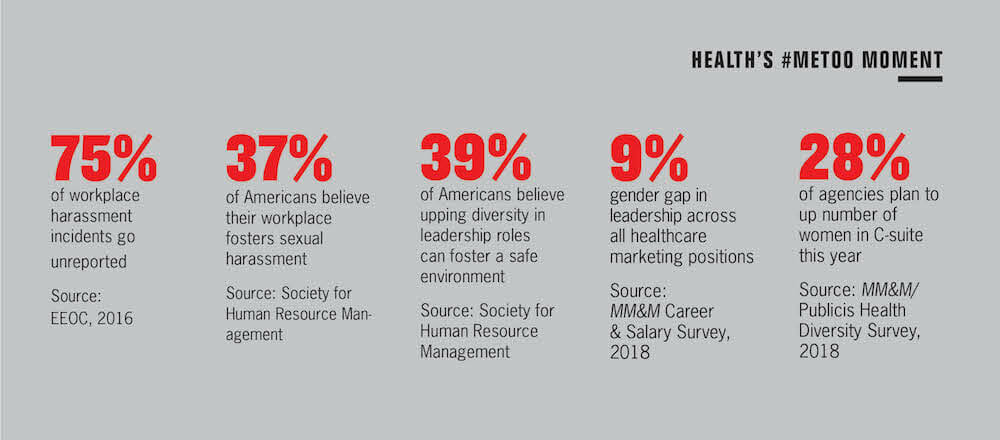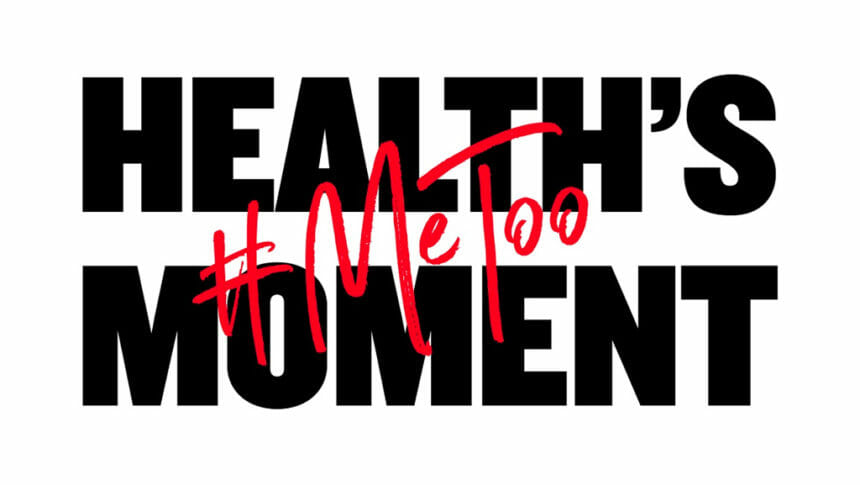The Equal Employment Opportunity Commission (EEOC) has estimated the vast majority of inappropriate behavior in the workplace goes unreported. That made July’s news that McCann Health had fired its chief creative officer, following what it said was an employee report about a violation of the company’s code of conduct, all the more revelatory.
See Also: McCann Health’s ex-CCO files $25M defamation suit, claims wrongful termination
The advertising trade media have chronicled a number of harassment and discrimination cases over the past 12 to 24 months taking place in consumer agencies — including the termination of Ogilvy’s worldwide CCO just one day before the McCann announcement, after an investigation into a complaint regarding his behavior.
Such conduct is not an anomaly in healthcare marketing. For example, at MM&M‘s first Hall of Femme event two years ago, women shared instances of gender bias in their careers.
Yet, here was a major healthcare marketing agency demonstrating zero tolerance and swift action. McCann’s CCO, Jeremy Perrott, was terminated, allegedly after an investigation into accusations he used “offensive and inappropriate language.”
In the three months following the incident, Interpublic Group had not clarified the nature of the language, how it was perceived, or whether the report was made by a man or a woman. The network referred MM&M to an earlier public statement about the matter: “Our foremost priority is to foster a workplace where people are respected and valued, and importantly, an environment where people feel safe and protected to come forward to report actions that run counter to our values and code of conduct.”
However, in late November, MM&M attained a copy of a complaint filed by Perrott in a U.S. District Court in Virginia in which he outlined the accusations that led to his dismissal — that he allegedly said to a woman “nice rack” and “nice ass,” statements which he denied making.
Moreover, the suit argued, the defendants had not offered up any proof that he made such comments before terminating him on June 12. Perrott’s lawyers charged McCann WorldGroup and parent IPG with defamation, tortious interference with contract, common law conspiracy, and gross negligence. He is seeking damages in excess of $25 million.
The defendants had filed a motion to extend the time to respond until December 17. And in a joint statement from IPG and McCann, the companies told MM&M, “We stand by our actions to protect our employees and our earlier and truthful statements. We will defend the case vigorously.”
After the firing, women leaders told MM&M the move did signal that enforcement action is catching up to improper behavior in this part of the agency world. Three months later, we asked agencies whether this was a watershed moment for health, one that perhaps has prompted agencies to do more to ensure they are meeting the new expectations for safe workplaces.
We found the incident is reverberating among large and small agency alike, and that healthcare marketing firms have been doing quite a bit, including shoring up their policies for employees to report this kind of behavior, and fostering an environment where people feel it’s safe to report.
‘A long journey’
“Many agencies already had zero tolerance approaches before this past year that were very much enforced,” explains Becky Chidester, founder and CEO of Wunderman Health. “What has changed is some agencies are now making their enforcement much more publicly visible and in doing so, pressuring any others that are not already enforcing zero tolerance approaches to do so.”
Indeed, the incident served as a very tangible sign that enforcement and demonstrably swift action are catching on. “More broadly, what we are seeing is the business world taking lots of exciting steps forward but on something that is a long journey,” adds Chidester.
The holding companies typically have in place multiple avenues for employees to communicate workplace concerns. In IPG’s case, these range from anonymous surveys and alert lines to direct channels to managers, HR, and the legal department, a spokesperson told MM&M.
More broadly, what we are seeing is the business world taking lots of exciting steps forward but on something that is a long journey
Becky Chidester, Wunderman Health
Some are making the process even easier.
Publicis Health recently rolled out a formal policy to encourage more reporting. The move follows a study from the EEOC that found between 87% and 94% of employees who have experienced workplace harassment do not file a formal complaint.
That’s “an astonishingly high number that needs to be remedied,” says Shannon Boyle, global talent manager for Publicis Health. The network introduced Speak Up, an addendum to its standard employee anti-harassment and anti-discrimination policy, allowing for three additional pillars in its reporting process:
Self-reporting. Those who believe they’ve been personally involved in a situation that resulted in violation of company policies are still expected to speak up.
Non-retaliation statement. Anyone who attempts to retaliate against an employee for speaking up will face disciplinary action, which may include termination.
Confidentiality. Relevant information is shared on a “need-to-know” basis only with individuals responsible for investigating and resolving the concern. The HR teams work with corporate and employment counsel to determine how best to investigate and resolve any reported incident of harassment or discrimination.
In terms of enforcement, a partnership between HR and business leads ensures the proper follow-through after an incident has been reported, explains Boyle. Although its reporting addendum just rolled out, Publicis Health says the effort predates the McCann firing.
“It may be trendy to talk about creating ‘safe spaces’ at work because of the emergence of the Me Too and Time’s Up movements, but workplace safety isn’t simply an HR issue,” she adds. “It’s a fundamental business imperative that can mean the difference between success and failure.”
The cost to companies is huge, from lost productivity to mounting legal fees, she says, not to mention the toll these cases have taken on morale in the affected agency and on its bottom line. That cost, in theory, could include everything from delaying or stopping work to the potential loss of clients.
Leadership gap
Another tangible sign is the progress agencies are making to advance diversity and inclusion. Agencies that have diversified their senior executive ranks have a better shot at promoting healthy environments that minimize bad behavior.
“We have made, in some ways, a lot of strides to be diverse in the industry, certainly from a gender parity [standpoint],” says Alison Stockley, a content strategist at Concentric Health Experience who also leads the agency’s diversity and inclusion initiative.
Speaking at a September panel discussion MM&M convened to discuss this topic, she said the agency is 53% female and has achieved, as she put it, “equilibrium” in the C-suite and at the executive level. “We continue to promote women to advance in their careers.”
Yet, exceptions abound. Analysis of data from MM&M’s latest Career and Salary Survey reveals an overall lack of gender equality in leadership roles. The survey revealed that 52% of all respondents employed across biopharma/medical device manufacturer and agency positions in the U.S. healthcare marketing, media, and comms sector are female.
However, there is lower female representation in leadership positions (director level and above), with only 43% of women holding these roles. This equates to a nine percentage point “leadership gap.” In terms of employer, this gap is most pronounced among manufacturers (only 24.8% of women are directors). Agencies are doing better, with 40.8% of women at director level or above. In terms of specific sector, OTC (12.4%), medical device (23.8%), and biotech (26.7%) all lag.

The existence of a leadership gap is one more hurdle to creating an inclusive workplace. Can closing it contribute to an environment where women and men are more likely to come forward and report bad behavior?
Yes, says Anat Lechner, Ph.D., clinical associate professor of management and organizations at NYU Stern School of Business.
Dr. Lechner says having more women in senior roles has been shown to make organizations less prone to sexual and gender harassment. Why? Not because senior women block such incidents — sometimes women are the aggressors — but because male-dominated, super hierarchical organizations are more likely to have cultures characterized by a so-called “bro” culture and to be more forgiving when it comes to bad behavior.
“It goes to the issue of how permissive is the organization of sexual harassment, and permissibility is tied to leadership,” she adds.
“Hence, the more women leaders, the greater the likelihood that a culture of impermissibility will be present.”
A 2018 study by MM&M and Publicis Health showed agencies are making incremental progress addressing the leadership gap, with some 28% saying they plan to increase the number of women in the C-suite this year.
‘A sense of victimization’
The deeply charged national conversation about sexual harassment — sparked to a large extent by the October 2017 Harvey Weinstein allegations, after which dozens of high-profile men in various industries, including advertising, have been fired or resigned from their jobs — has heightened consciousness in and around healthcare.
Some of the healthcare agencies told MM&M they have made “little to no changes” since the McCann Health firing. Others said they “never tolerated behavior that was inappropriate in any way.” Others chose not to talk about incidents of bad behavior.
“That’s the wrong way to go about it. Transparency is important, particularly in a publicly held company,” urges attorney Lisa Bloom, who heads The Bloom Firm in California, the largest civil rights law firm in the country dealing primarily with sexual assault and sexual harassment cases.
“The [broader] ad industry is very concerned about appearances, so they don’t want transparency,” says Bloom. “But these stories are increasingly coming to light, whether they like it or not, and women are increasingly speaking out despite confidentiality clauses.”
Given that the ad sector maintains several vestiges of the Mad Men era, from a culture of entertaining clients to working late nights and lots of travel, Bloom says the industry “has a long way to go.”
As women and men continue coming forward, not everyone believes this is having a positive effect on advertising. “I think the situation here is beyond the #MeToo wave, but more a broad sense of victimization that has swept through the social media channels, which has rendered everyone too careful, sensitive, scared, and quick to judge,” says Didi Discar, founder and former CEO of the healthcare agency Carling Communications.
This trend is unisexual, but affects the potential for strong creative, she adds. “Provocative creative must not only be artful but must also be strategically clever, and clever goes hand-in-hand with an element of surprise. So how does a creative genius surprise his or her target audience when there’s a constant fear that he or she might inadvertently offend someone?”
Because of this, Discar argues, the industry is at serious risk of accepting “mediocrity,” not for lack of creativity, “but for the fear that pushing the creative envelope would result in the brand, company, or agency being on the wrong side of the social norm train tracks.”
Bloom, the attorney, rejects what she sees as a false dichotomy, between the brilliant but brash creative on one side, and the safe workplace on the other. “We can have brilliant, creative, hard-working people who don’t sexually harass,” she says. “It’s the same when we talk about affirmative action. People say we have to lower our standards to have affirmative action. No, we don’t. You can have high standards and diversity.”
She also has advice for those companies who choose to cover up said issues.
“As Supreme Court Justice Louis D. Brandeis once said, ‘Sunlight is the best disinfectant.’
Let’s get it out. Let’s tell the truth. Let’s not look like we’re covering up for bad behavior,” Bloom continues. “If you want to turn a corner and learn how to do things better, that’s the better way to go.”
From the December 01, 2018 Issue of MM+M - Medical Marketing and Media







